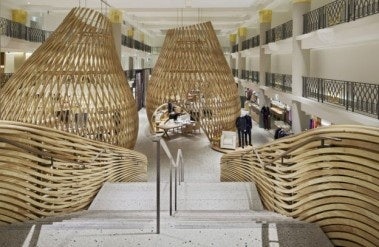14,500-Square-Meter Store On City's Left Bank Expected To Entice Well-Heeled Chinese And Other Tourist-Shoppers#

This week, Suzy Menkes of the New York Times takes a look at the new, super-sized Hermès flagship in Paris, a temple to international commerce she describes as "a way station on a new Silk Road, designed as a destination for shopping tourists, who increasingly come from China." From the article:
Patrick Thomas, president and chief executive of Hermès, says that the new project at 17 Rue de Sèvres is intended to draw local customers who might not make it to the landmark store on the other bank of the Seine. But the executive also says that visitors from Hong Kong, Macao, South Korea and Taiwan, as well as from China, already make up 4 to 5 percent of Paris shoppers — and account for 17 percent of the company’s fast-growing sales figures. There are 70 pan-Asia stores (excluding the 50 in Japan) — double the 35 shops across France.
The lure of lavish flagships, in Paris as in elsewhere, to Asian luxury consumers hasn't faded over the past 30 years, even as Japanese tourist-shoppers have been supplanted by South Korean, then Taiwanese, and now mainland Chinese. In their 2006 book The Cult of the Luxury Brand: Inside Asia's Love Affair With Luxury -- critical reading for anyone interested in the Asian luxury market -- Paul Husband and Radha Chadha write,
[In Japan,] the mega-flagship trend was started by the $138 million La Maison Hermès in 2001 -- a stunning 11-story glass brick store in Ginza, Tokyo's primary shopping district -- and more flagships have been popping up ever since like popcorn in a microwave. The bar was set so high that soon everyone was calling on top architects, including Japan's finest, to create spectacular monuments that embodied the spirit of their brands. Not far from Hermes' building is Chanel's dazzler on Chuo Dori: Designed by American architect Peter Marino, its glass facade projects Chanel's signature tweed pattern. Louis Vuitton held a design competition and winner Jun Aoki created the "randomly stacked trunks" building on Omotesando.

In building its newest Parisian "luxury cathedral," in the words of Husband and Chadha, Hermès recognizes that the situation is quite different for consumers in places like China than it was for the previous generation of Asian tourist-shoppers from Japan or South Korea. In China, though Hermès boasts a number of boutiques in 16 cities, it currently lacks a mega-flagship on the level of that found in Ginza. However, much of this is likely due to a keen understanding of the idiosyncrasies of the mainland China market, more than anything else.
Hermès knows two important things about the China market as it stands today: first, that wealthy Chinese luxury consumers would gain greater prestige back home by shopping at the new Paris flagship than they would at an equally lavish Shanghai flagship, and second, that the relatively lower price in Paris (or even Hong Kong, for that matter) due to China's high luxury tax, means that fewer potential buyers -- at least in wealthy top-tier Chinese cities -- will shop locally. As a result, it would take far longer for Hermès to see a return on investment from a multi-million-dollar flagship in Shanghai or Beijing than it would in Paris, Tokyo, or possibly even New York.
However, it would be foolish to think that Hermès, by focusing on smaller boutiques and strictly limiting its China expansion, is missing opportunities. Preserving its exclusivity by avoiding the ubiquity of brands like Louis Vuitton is a company trademark, and with the recent launch of Shang Xia -- the homegrown Chinese brand it supports -- Hermès is showing a deeper interest in Chinese design and culture than other imported brands, some of which fall back on Orientalist motifs that have, at times, left Chinese consumers cold.
So, in essence, if Hermès doesn't have to build a China flagship that rivals Louis Vuitton's in Shanghai or Burberry's in Beijing right now, why should it rush?